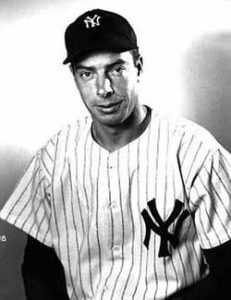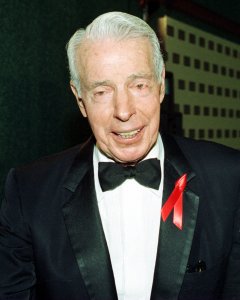With baseball season in full swing and some teams, like my Kansas City Royals foundering, the conversation, as it often does, comes around to the greatest baseball players of all time.
Discussions like that are exasperating and always incomplete—especially when the discussants represent multiple generations. Evaluating baseball players from different eras is a hopeless, unremitting endeavor. So I am not going to go there.
What I will do, however, is share with you a front-page story I wrote for the Chicago Tribune on the occasion of Joe DiMaggio’s 65th birthday, November 25, 1979. Joe died 20 years later on March 8, 1999, eight months before his 85th birthday.

My story on DiMaggio remains one of my favorite efforts during my 27-year career with the Tribune.
Now, I realize there may be some (but only some) who may not know who “Joltin Joe” DiMaggio was. Let’s just say that along with Babe Ruth, Lou Gehrig, Alex Rodriquez, Mickey Mantle, Derek Jeter, Yogi Berra, and Whitey Ford, Joe DiMaggio, also known as the “Yankee Clipper,” resides in the pantheon of New York Yankee greats. His career spanned 15 years from 1936 to 1951, with two years away (1943-45) in the U.S. Army Air Force during World War Two.
During his career, he was a three-time Most Valuable Player winner, but he is best known for his 56-game hitting streak in 1941—a record that still stands today. He compiled a lifetime batting average of .325. He was twice the American League batting champion—hitting .381 in 1939 and .352 in 1940. He also led the American League in home runs with 46 in 1937 and 39 in 1948.
DiMaggio was known for his grace in center field and was considered, along with Willie Mays, one of the best center fielders of all time.
But he is also known for something else. Many considered him the symbol of an era in America that we will never see again. It was an era memorialized in Simon & Garfunkel’s classic song “Mrs. Robinson,” which was written at the height of the unpopular Vietnam War when the nation was ripping itself apart and many longed for a simpler, less divisive time.
The lyrics of that song say it all:
“Where have you gone, Joe DiMaggio,
Our nation turns its lonely eyes to you.
What’s that you say, Mrs. Robinson.
Jolting Joe has left and gone away,
Hey, hey, hey
Hey, hey, hey.”
So when I suggested to my editors at the Tribune that I interview DiMaggio when he turned 65, I knew I would be interviewing a legend. The problem was getting the interview. Joe DiMaggio was a very private person. He didn’t like doing interviews. Luckily for me, Dave Condon, a long-time sports writer/columnist at the Tribune knew Joe well and called him for me.
“Ron’s not a sportswriter; he’s a foreign correspondent, and he was in Saigon when it fell,” the writer told DiMaggio. That bit of information intrigued DiMaggio, who had gone to Vietnam many times to support and entertain the troops.
“Okay, can he be here next Wednesday morning?” Joe asked. “I’ll give him an hour.”
As it turned out, Joe and I talked for more than three hours. It was more of a conversation than an interview, and I could tell Joe felt at ease. At one point he even invited me to join him and some of his old buddies from the San Francisco 49ers for lunch in a private room in the back of the restaurant.
“We sit around and swap lies,” DiMaggio told me. “You might get a kick out of it.”

He didn’t have to ask me twice. What an experience. It’s one of the few times when I agreed to keep my notebook closed.
“I don’t want the guys to get nervous,” Joe said.
DiMaggio introduced me this way: “Ron’s a war correspondent. Left on those evacuation helicopters from Saigon back in 1975. He has some great stories.”
But the “great stories” were not mine. They came from Joe and the others that November afternoon 43 years ago in a backroom of DiMaggio’s restaurant near San Francisco’s Fisherman’s Wharf.
It was one of those times that I thought to myself: I have the greatest job in the world. I can’t believe I get paid to do it.
To read a .pdf copy of the story I wrote click on the link below:
Where have you gone, Joe DiMaggyo, Nov. 25, 1979


Ron, I’m sure you know this, but I’ll drop it in for the benefit of any of your readers who may not have heard this piece of trivia: Paul Simon’s original title and lyrics for what became “Mrs. Robinson” were “Mrs. Roosevelt,” who was First Lady for the high points of Joe D’s career. Paul Simon changed the wording to “Mrs. Robinson” for the movie The Graduate. BTW, your ’79 article had a special meaning for me because I had been one of those kids mentioned in your page-12 headline, “Kids Still Ask for Autographs.” Joe signed a baseball for me in ’56.
That’s great that you have a signed baseball from the Yankee Clipper. I never saw Joe play in person, but I recall watching the Yankees sweep the Phillies in the 1950 World Series. Joe D. hit a homer in game two to give the Yankees a 2-1 win. I was in the 4th grade and my teacher, Mrs. Rush, hooked up a B & W TV in the classroom (with a whopping 17-inch screen) so we could watch the game. As I recall, most of the girls moaned about it, but we boys were elated. I remember Mrs. Rush said Joe DiMaggio was the best player in baseball. I think only about half of the kids in that class had a TV set in their homes, and I was one, so it was a real treat for a lot of us.